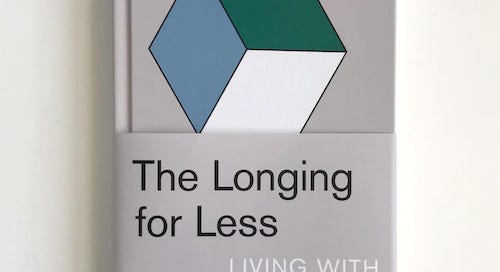Hello! This is a special newsletter edition with only one request: that you consider buying my first book, The Longing for Less: Living with Minimalism, which came out this past January, as a holiday gift for yourself, for your friends and loves ones, or just as a way of supporting my writing. Here are some ways you can buy it:
Bookshop (sends money to indie bookstores)
Amazon (evil but convenient)
Bloomsbury (my publisher)
The book is a beautiful object, as you can see below, but I will also make other arguments for its quality:
The desire to talk about art was what first pushed me into writing as a profession. I wanted to communicate what I loved about the art I saw, and what I got from looking at it, to other people. I like using art and aesthetics more broadly as a way of seeing the world around us and taking stock of human culture. This book is the farthest I’ve gone down that path, with years of my life dedicated to understanding a single topic, the emergence of Minimalist art in the 1960s and the ways in which it has become an entire commodified lifestyle, maybe the dominant aesthetic of our time.
Art can often be intimidating to talk or read about, but I’ve heard that my writing isn’t. I want to share the pleasure that I get from these things, whether it’s Donald Judd’s metal boxes or Agnes Martin’s ethereal grid paintings or Spotify’s feeds of ambient music. This book was my way of understanding how culture works today and how a rarefied, widely misunderstood idea can transform into something entirely different from its origins. In the end, it’s an attempt to return to the core idea of Minimalism, that we should break down the barriers between our perceptions and the world and find beauty in reality as it is. As Judd wrote: “Art is everything at once.”
Other reasons to buy The Longing for Less:
— It’s a critique of Marie Kondo-style minimalism when that paradoxical form of consumerism is still rampant. (Check out Kondo’s ecommerce shop.)
— The book suggests a playlist for Minimalist music (great for working from home!) including Satie, Brian Eno, and Julius Eastman.
— Jia Tolentino reviewed the book for The New Yorker, writing that it “arrives not as an addition to the minimalist canon but as a corrective to it.”
— It’s organized into short segments (four chapters with eight sections each) that you can read right before going to sleep, as I prefer to read all books.
— The fourth chapter sketches out the arc of Japanese cultural history around the beauty of ephemerality, including my favorite historical figure, Kuki Shuzo.
— When you take the dust jacket off it makes for great decor!
Again, lots of ways to buy it: Bloomsbury / Bookshop / Amazon / Indiebound / Barnes and Noble / Books-a-Million
For signed copies, get in touch with me directly at chaykak@gmail.com. If you send me your fresh receipt I’ll email you an in-progress multimedia companion to the book (aka a google doc, which will eventually be public).
If you’ve liked my writing this year, please pick up a copy of the book. It’s not about technology literally, but I think philosophically it’s very relevant to my more recent work. (My next book will be about digital tech.)
I’ll write more about this soon, but I’m also embarking on a new daily newsletter project called DIRT. It’s about entertainment and streaming culture. You can sign up for it here and every day you’ll get a few paragraphs from me or another writer you’ll like about Netflix, TikTok, Spotify weirdness, etc. A representative edition is my dispatch about “instant fandom,” or why we tweet about TV shows.
If you liked this newsletter, please hit the heart button below! It helps me reach more readers on Substack. Email me at chaykak@gmail.com or reply. Also:
— Follow me on Twitter
— Buy my book on minimalism, The Longing for Less
— Read more of my writing: kylechayka.com




